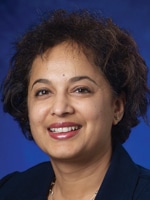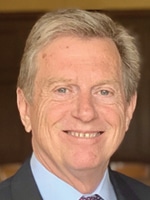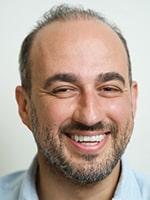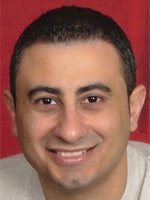August 2023—Anatomic pathology laboratories—the pressures, the promise of technology to alleviate them, and the seemingly unprecedented rates of change. CAP TODAY publisher Bob McGonnagle gathered pathologists and company representatives online on June 21 to talk about it all.
From pathologist coverage to IT, from tumor boards to questions job candidates in pathology should ask, here’s what they told us.
Katie Robertson, where is the focus at Roche now for your anatomic pathology customers?
Katie Robertson, PhD, disease area network lead–oncology, Roche Diagnostics: Our focus now is digital pathology, everything from implementation and scanners to third-party algorithms and our own algorithms.
Ghislain Noumsi, what about at Agilent?
Ghislain Noumsi, MD, MBA, SBB, global head of medical affairs CDx/pathology, Agilent Technologies: It’s digital pathology and how we can deliver an end-to-end solution that integrates different testing strategies in immunohistochemistry, molecular, and so on.
Jeff Prichard, how is the pathologist shortage affecting Geisinger?
Jeffrey Prichard, DO, division chief, anatomic pathology operations, informatics, and quality, Geisinger Medical Laboratories: We’re spread thin in trying to cover cytology and rapid onsite evaluations. We’ve moved to telecytology for pathologists to cover it centrally so we can have cytotechnologists in each of the sites across the state prepare slides and have the adequacy evaluations done by the cytologist. We’ve had to stop our coverage of endocrinology rapid onsite evaluation.
Can you comment on subspecialty pathology as it’s practiced at Geisinger?
Dr. Prichard (Geisinger): We are partially subspecialized. Each of us has our own specialties, some larger and some smaller. We cover some of the larger ones as a group so we can make sure we have enough people to supply service. Each of us assumes one, two, or three different services. We can share coverage through telepathology across hospitals in the state and have subspecialists in different sites collaborating with each other. That’s how we’re able to provide the subspecialty service we have.
Ari Rao, what’s top of mind for you as a system chief?

Dr. Rao
Ari Rao, MD, PhD, senior vice president, BSW system chief pathology and lab medicine officer; endowed centennial chair, Scott and White Clinic Pathology, Baylor Scott & White Health: As a system we have three groups of pathologists, an employed group and two private groups. Trying to standardize among the three groups is a key task for me as a system VP. For the employed group, which is present at 15 to 18 facilities across the state with more than 300 to 400 miles between each one, telepathology coverage and using the available digital tools is important. At the same time, the courier system has to be robust because no matter how much digital you do, there’s a need to have a backup with slides. Standardizing that, organizing the histology lab and getting those workflows in place, having subspecialists get their slides and cross-covering others, getting transplant pathology coverage, weekend coverage, and enough pathologists to cover 24/7, and then maintaining quality on top of it and having system standardization for each of those metrics—all are a challenge.
Pete Dysert, we are almost in a perfect storm for pathology. We have a shortage, growing clinical demands and needs for subspecialty expertise, and increasing technology and instrumentation costs. Is that a fair comment on what it’s like to be at the bridge of a large pathology ship these days?

Dr. Dysert
Peter Dysert, MD, chief, Department of Pathology, Baylor Scott & White Health: I’ll start by saying, If you don’t like change, I hope you like being irrelevant. There are forces at work causing change in all aspects of medicine, but in pathology at unprecedented rates. When I think about this, I begin with the process of medical education. Many of the challenges we have with staffing are directly related to the curriculum changes that have taken place in medical schools for pathology. The net result of those changes has put pathology at somewhat of a disadvantage in competing for people who see pathology as their future profession.
Looking at it through the training cycle, people seem to want to carve out and practice a subspecialty version of pathology that puts constraints on coverage. I’m also seeing a growing appetite for subspecialization on the clinical services side as clinical subspecialty organizations offer recognition and accreditation.
In addition, the demand for new technologies is growing; it’s an ever-changing field and landscape. We seem to be constantly behind in our ability to serve up those results through our LIS platforms, because as health care systems grow in size and scale, the change process is even more difficult. Yet those results are so important in the translation of that information for the care of the patient. I feel like I’m in the middle of a perfect storm and struggling to keep up and figure out how to deal with these issues and see them not as negatives but as opportunities.
Jeff, can you comment on what Pete described? Are you largely in agreement?
Dr. Prichard (Geisinger): Yes. I’ve spoken to the challenges of subspecialization and being spread so wide, and IT is going to be key to almost everything we do. IT is a form of automation we can implement to automate testing algorithms and share our telepathology expertise across the systems.
IT is being stressed from a human resources standpoint, even more so than pathologists and professional staff. We’re trying to get more and more out of them and with fewer and fewer people.
Suren Avunjian, your customers’ headaches are your headaches. Tell us what you make of the situation and what you suggest might give us relief at this time.

Avunjian
Suren Avunjian, co-founder and chief executive officer, LigoLab Information Systems: Reimbursement issues are adding to the perfect storm. Advanced and comprehensive technology platforms and the right kind of automation can offer solutions that directly address that challenge and the challenges of escalating costs and labor shortages. Innovative revenue cycle management technology solutions can provide critical support in dealing with declining reimbursements. By leveraging advanced rule sets, strategies, and analytics, labs can gain better control of and insight into their technical and financial operations, identify areas of waste, and make informed decisions that enhance collections and profitability. Artificial intelligence and machine learning can play a crucial role in helping to mitigate the impact of pathologist shortages.
LigoLab integrated with BioImagene [acquired by Roche in 2010] as a digital pathology partner more than a decade ago. Since then we’ve established integrations with a host of whole slide imagers and developed an agnostic platform. This enables rapid integration with an array of digital pathology solutions and provides a marketplace layer for AI technology, tailor-made for different machine learning models and specific to each stain and specimen.
As more practices embrace digital pathology, these technologies will prove increasingly valuable. We’re seeing this trend among our pathology customers, many of whom have already initiated a digital pathology strategy or plan to within the next 12 months.
One of our key initiatives is developing a cloud-based EHR integration network. With this engine, customers that join LigoLab gain automatic access to all EHRs integrated into the cloud network. This happens without the need for individual labs to rebuild them. Point-to-point interfaces have created considerable struggle and costs within our industry. Our cloud-based integration engine aims to eliminate these pain points.
Ed Youssef, talk about the challenges of scale when you’re looking at a pathology operation that is across the state of Texas or Pennsylvania, as with Baylor Scott or Geisinger. It requires a lot of work on the vendor’s part, doesn’t it?

Youssef
Ed Youssef, chief strategy officer, NovoPath: It does. At NovoPath our focus is the automation process. How do you automate the work for the functional teams within the lab? We’re studying the different workflows for each subspecialty to figure out where in the process we can automate as much as possible. The more we can automate, the easier it becomes to scale. As the organization grows, vertically or horizontally, once you deploy the automation, the system can take over and provide efficiencies for the users, which will help with the technologist and pathologist labor shortages. It also helps in certain subspecialties where there are highly technical workflows.
Megan McCartney, everywhere I go in the country, people report that histotechnologists are doing two, three, and four different jobs. Can you comment on that particular long-standing shortage?
Megan McCartney, MS, CT(ASCP)CM, HTL, manager of laboratory operations, cytopathology and histopathology, Baylor Scott & White Health: There’s a national shortage not just of histotechnologists but cytotechnologists as well, and the general public’s lack of knowledge about laboratory professions and the lab sciences is contributing to that shortage. We are in the background and not many people know what we do in order to produce what the pathologists need to make diagnoses. I think there’s a shortage, too, because people were forecasting several years ago that technology would take the place of humans in the laboratory—cytotechnologists in particular—and cytotechnology programs were closed. An educational outreach of what we do and the impact we have on patient treatment plans and patient care would greatly benefit our entire AP lab.
Dr. Rao, can you give us more detail on what the needs are in pathology today?
Dr. Rao (Baylor Scott & White): Many therapeutic decisions are being made differently than they were five years ago. There are new medications especially in oncology but also in other fields—cardiovascular disease and degenerative brain disorders, for example. Every one of these fields is changing, and it seems like the areas of diagnostic medicine—pathology and radiology—are the canaries in the coal mine. The decisions that are changing medicine are hinging on what we can do up front, which means we have to do things more rapidly and use as much new technology and as many new markers as possible.
Then you throw in AI and possibly the new generative AI that’s taking over the world, and things are rapidly changing everywhere. Just a few years ago we were thinking, “Okay, we’re going to change pathology processes to have a hub-and-spoke model.” Now we’ve gone way beyond that in saying, “What is the fastest? Is it at each facility? Do we need to do everything everywhere?”
 CAP TODAY Pathology/Laboratory Medicine/Laboratory Management
CAP TODAY Pathology/Laboratory Medicine/Laboratory Management
